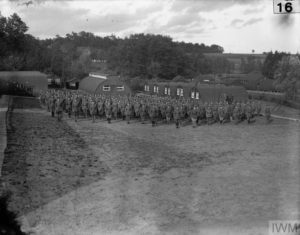Wednesday August 21st, 1918
Still feeling better, got up a little today. Meet Lowe and he says that all are going home on leave, so I must get away.
Training the Troops
According to the BWD, the 9th is taking on three more second lieutenants to strengthen its officer complement. One of them, 2Lt Foy, is to join B Company. Frank is starting to feel better and Lowe, in his unit, tells him that they are to be granted home leave. Frank must be very excited. He has been in the Army for over a year now and apart from a short leave in November 1917 before he set off for Salonika, he hasn’t been home since.
Frank’s training started just after he joined the Colours in July 1917. He trained at various camps around the Yorkshire coast for four months. This included General Musketry for 12 days at the beginning of October, followed by a special course for Lewis Guns in November when he proved to be a good shot. He left Yorkshire for Marseilles, en route to Salonika, on November 28th, 1917.
Structuring the Armies
Over 1917-1918, 42 American Divisions were sent to France and a further 12 were almost ready to be mobilized when the war ended. Just over half were engaged as active combat divisions during the last three months of the war. A Division in the US Army was about a thousand officers and 27,000 men. Like the British Army it was the building block and permanent formation of the Army.
Typically a British Division comprised three Brigades. On average it was probably a third smaller than a US Army Division. In 1918 there were 60 British Divisions on the Western Front.
Training the American Officers
To support its planned size, the American Army needed 200,000 officers. At the beginning of the war it had only 20,000. To facilitate their training, Britain and France sent some of their best officers and senior NCO to the United States.
They provided a variety of instruction. The British team covered gas, physical training and bayonet, machine gun, sniping, trench mortar, company commanders’ courses and artillery. To complement this the French provided instruction in artillery, liaison, minor tactics, fortifications, automatic rifles, hand grenades and general field and staff officer training.
This support was very well received. ‘These groups of foreign instructors attached to training schools, divisions, and other units, rendered service out of all proportion to their number. They were a significant contribution to our training program.’²
Training the American Troops

Statistical analysis after the war of 1.4 million US troops revealed the following. ‘The average American soldier who went to France received six months of training [in the USA] before he sailed. After he landed overseas he had two months of training before entering the battle line. The part of the battle line that he entered was in a quiet sector and here he remained for one month before going into an active sector and taking part in hard fighting.’ ³
The photograph shows American Officers with their instructors at the 11th British Corps School.^
Despite this extensive training, General Jack, a noted stickler for procedure, had mixed views:
‘A company of the 3/120th [º] American Regiment is in the Line, attached to my battalion….The Americans are big, manly fellows, free from brag and anxious to learn; but from our point of view they are a little careless about duties and lose too much of their gear.
They are excellent friends to our men, and have expressed their gratitude, so I hear, for the return of a portion of their missing rations. The Americans are naturally strange to this life and, for practice, relieve their platoons, mixed up with ours, every night.
The company commander does not impress me, but his senior subaltern is a splendid young fellow. I asked him what kind of shots his men are; he replied in a slow drawl, ‘Well, sir, I guess they got lots of practice on Revenue officers in Arizona.’¹
9th Battalion / Manchester Regiment War Diary – 21st August 1918 – Haudricourt
Training and work as per programme. The following officers reported for duty and are taken on strength and posted to Coys as shown:- 2Lt WF Laird D Coy, 2Lt JF Foy B Coy, 2Lt FL Egan A Coy. 1 OR having rejoined is taken on from 21-8-18.
References & Further Reading
¹ ‘General Jack’s Diary, War on the Western Front 1914-1918’ edited by John Terraine, Cassell, 2003, originally published 1964, page 252
² ‘The War With Germany, A Statistical Summary‘ by Leonard P Ayres, Colonel, General Staff, Chief of the Statistics Branch of the General Staff, Washington Govt Printing Office, 1919, page 31
³ ‘The War With Germany, A Statistical Summary’, page 25 (based on data for 1.4 million troops)
^ Q 226, copyright Imperial War Museums
º The diary stated the 3/120th however looking at the structure of the AEF it appears this might be the 30 Division/120th Regiment. Thoughts?


